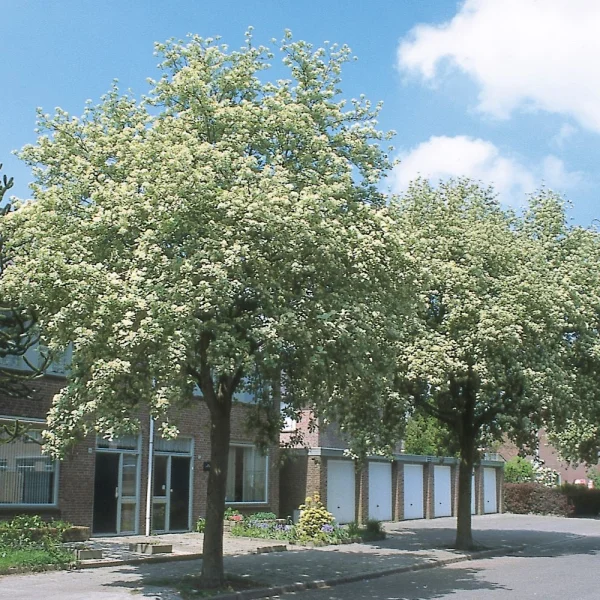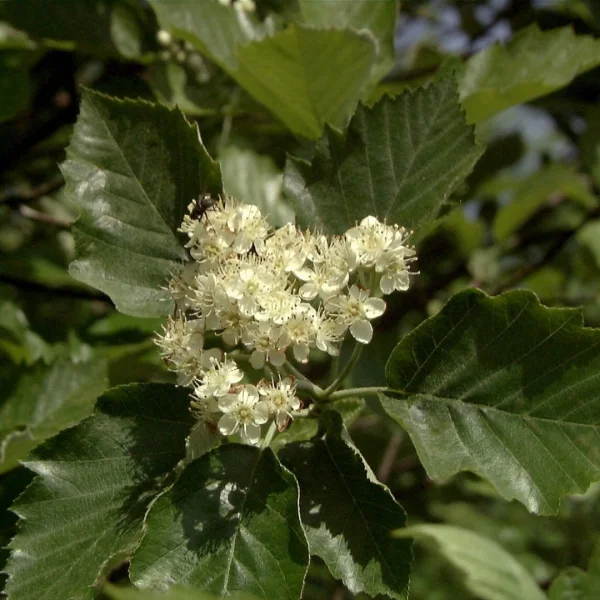Sorbus alnifolia var. submollis – Sorbus alnifolia var. submollis
Rosaceae
Sorbus alnifolia var. submollis – Sorbus alnifolia var. submollis
Varietatea naturală submollis nu diferă prea mult de specia Sorbus alnifolia. Este un arbore de talie mică sau medie, de 8-12 m, cu o coroană închisă, ovoidală sau rotundă. Scoarța este cenușie închisă și netedă, iar crengile tinere sunt de culoare maro verzuie, cu muguri foliari de culoare roșie-maronie frapantă. Frunzele ovale seamănă oarecum cu cele ale lui Alnus spaethii, dar sunt mai mici. La specia Sorbus alnifolia, frunzele sunt glabre pe ambele fețe. La var. submollis, partea inferioară a frunzelor este ușor păroasă. Chiar și pe frunzele mai bătrâne, această pilozitate poate fi încă observată în crestele nervurilor. Toamna, frunzele capătă o culoare atractivă roz, portocalie și roșie. În lunile mai-iunie, florile albe se deschid în corimbi de aproximativ 5 cm lățime. În timp ce pedunculii florali ai speciei S. alnifolia sunt glabri, cei ai var. submollis sunt pufoși și păroși. Florile sunt urmate de fructe rotunde până la ovale, care se transformă din galben în roșu. Polenizarea încrucișată este necesară pentru o bună fixare a fructelor. Așadar, plantați întotdeauna cel puțin doi pomi unul lângă celălalt. Sorbus alnifolia var. submollis se întâlnește în China centrală, Coreea și Japonia. Arborele crește de preferință într-un sol bine drenat și fertil. Zona de rezistență 4.
This product is currently not available.
You can submit your request via the contact form, we will inform you without obligation about the possibilities.
Specifications
Download PDF
Height
8-12 m
Width
4-8m
Crown
avoid to round
Bark and branches
dark grey
Leaf
dark green
Autumn colour
orange, red
Flowers
white, flowers in May-June
Fruits
yellow to orange and red
Spines/thorns
None
Toxicity
usually not toxic to people, (large) pets and livestock
Soil type
sandy soil, acid soil
Paving
tolerates partial paving
Winter hardiness zone
4 (-34,4 to -28,9 °C)
Wind resistance
fairly
Other resistances
resistant to frost (WH 1 - 6)
Fauna tree
aluable for bees (honey plant), provides food for birds
Application
avenues and broad streets, narrow streets, tree containers
Origin
U.S. National Arboretum, Washington D.C., USA, 2003
Possibly of interest
Frequently asked questions
Sorbus alnifolia var. submollis
Sorbus alnifolia var. submollis can eventually reach a height of 8-12 m, depending on the site and climate conditions.
Sorbus alnifolia var. submollis has a average growing and can eventually reach a height of 8-12 m, depending on the site and climate conditions.
The leaves of Sorbus alnifolia var. submollis turn orange, red in autumn.
The right time to plant Sorbus alnifolia var. submollis is during the dormancy period. In Western Europe, Sorbus alnifolia var. submollis with root balls can generally be planted from mid-November to late April, although this depends strongly on the climatic conditions and the species of tree.
may, june.
General
 English
English
 English (United Kingdom)
English (United Kingdom)
 Nederlands
Nederlands
 Nederlands (België)
Nederlands (België)
 Deutsch
Deutsch
 français
français
 čeština
čeština
 polski
polski
 español
español
 română
română
 dansk
dansk
 svenska
svenska
 magyar
magyar
 Türkçe
Türkçe
 slovenčina
slovenčina
 русский
русский
 norsk
norsk








